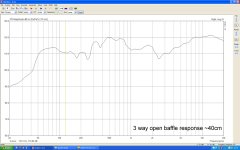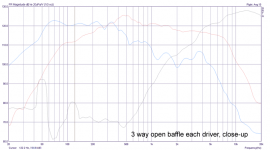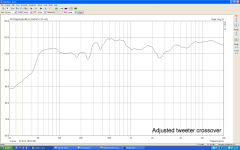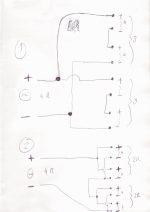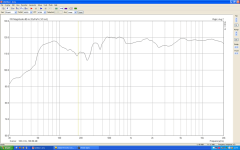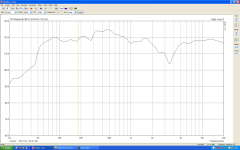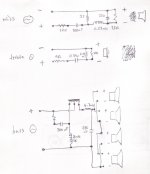Congrats to a wise decision. 🙂
Our ears can tell us if we like a sound or not. But they have a hard time leading us from good to better.
They tend to bend straight roads into circles.
Our ears can tell us if we like a sound or not. But they have a hard time leading us from good to better.
They tend to bend straight roads into circles.

Rudolf said:Congrats to a wise decision. 🙂
Our ears can tell us if we like a sound or not. But they have a hard time leading us from good to better.
They tend to bend straight roads into circles.
Very wise speak! I've only shied away from measurements before because it looks like a royal pain in the bum! But at least I know I can do a basic frequency response measurement using ARTA.
The mic pre-amp kit arrived yesterday and it's very nicely thought out indeed. The electret is tiny... still not sure quite how I'll prop that up in mid air - perhaps on a stiff piece of wire & camera tripod. We'll see. My 'net connection is down at home so I'll print the instructions at work hehe
Simon
ttan98 said:
I have the same fostex 167E on open baffle, I found the sound a little thin, overall sounds OK however if you have a better quality midrange driver the midrange would sound much fuller(I like fuller sound). On top of that it cannot handle power. For the price it is selling it is well worth it for the sound.
BTW I use an old alnico mid/woofer it sounds better than Fostex 167E
thats why i use the Peerless SLS 315 as woofer
x over 175 / 250 Hz 12 db..
driven by a Omnes Audio Amp 2.1 II 4 channel Tamp
the Fostex sounds ok to me and many others who
have listened to them...
I finished building the mic preamp last night and cut a short length of coax, onto which I mounted the Panasonic electret capsule and an RCA plug on the other end.
I fired up ARTA and got something on the screen. I obviously need to sort out some calibration now to make it work better. It's picking up a lot of 50hz from somewhere. Will read the instructions and set it up better tonight... watch this space!
Simon
I fired up ARTA and got something on the screen. I obviously need to sort out some calibration now to make it work better. It's picking up a lot of 50hz from somewhere. Will read the instructions and set it up better tonight... watch this space!
Simon
Will do!
After your post about this preamp and capsule, I also decided to buy one (too lazy to construct from scratch at the moment) and fired Vikash an email about how the calibration file is applied. He hasn't replied yet. Do the instructions tell you how? the ones on the site didn't seem to...
Cheers
Stuey
After your post about this preamp and capsule, I also decided to buy one (too lazy to construct from scratch at the moment) and fired Vikash an email about how the calibration file is applied. He hasn't replied yet. Do the instructions tell you how? the ones on the site didn't seem to...
Cheers
Stuey
Stuey said:Will do!
After your post about this preamp and capsule, I also decided to buy one (too lazy to construct from scratch at the moment) and fired Vikash an email about how the calibration file is applied. He hasn't replied yet. Do the instructions tell you how? the ones on the site didn't seem to...
Cheers
Stuey
Hi Stuey,
It's easy using ARTA. Simply rename the file to .mic (from memory that is the file extension ARTA looks for) then click on the relevant icon - I think the icon is red and blue but I'm at the wrong PC to look - on here you can load the file. You'll know if it's worked because it shows a green/black graph showing the adjustments it's making.
Sorry if that's too vague but I'm at the office. My home connection is down.
Simon
I think it's fairly ok to say it's all a bit of an experiment and learning experience. These are the individual drivers as measured using ARTA, mic close-up. I overlaid these in Fireworks. I'll learn how to use some proper speaker designing software in the future, but just doing this has helped enormously.
Attachments
Clearly I made the treble far too loud, there's too much overlap from the woofers and there's a dipole-induced peak from the mid driver, centred at about 500hz.
Based on this I decided to bring the tweeter in lower and reduce its level a lot (see attached). This sounded a lot better.
Based on this I decided to bring the tweeter in lower and reduce its level a lot (see attached). This sounded a lot better.
Attachments
Last night I decided to have more of a play around. I made the tweeter high-pass and midranger's low-pass filters both 2nd order and made various other changes!
The effect is the sound is MUCH smoother and vocals are a lot more realistic and characterful. The bass now sounds quite full due to not having the top end so cranked up. The (small) downside is a loss of life and attack. Graph to follow!!
Further measurements allowed me to see on screen the upper bass peak I've been complaining about previously. The peak is at ~120hz and comes from the left speaker (in the corner) ONLY. The right is very smooth in the bass.
As suspected through listening the lower midrange/upper bass area has a dip, which I will try to remedy by bringing just the top woofer in higher (and the rest lower).
Ignoring the 50hz hum boost, it's clear these speakers are good to about 50hz then drop off quite sharply. It would be much harder to hear a strong 50hz tone in a tiny bedroom from ported or sealed enclosures, and to have that without boom would be VERY unlikely!
Tonight's mission is to investigate the 120hz resonance....
Simon
The effect is the sound is MUCH smoother and vocals are a lot more realistic and characterful. The bass now sounds quite full due to not having the top end so cranked up. The (small) downside is a loss of life and attack. Graph to follow!!
Further measurements allowed me to see on screen the upper bass peak I've been complaining about previously. The peak is at ~120hz and comes from the left speaker (in the corner) ONLY. The right is very smooth in the bass.
As suspected through listening the lower midrange/upper bass area has a dip, which I will try to remedy by bringing just the top woofer in higher (and the rest lower).
Ignoring the 50hz hum boost, it's clear these speakers are good to about 50hz then drop off quite sharply. It would be much harder to hear a strong 50hz tone in a tiny bedroom from ported or sealed enclosures, and to have that without boom would be VERY unlikely!
Tonight's mission is to investigate the 120hz resonance....
Simon
Attachments
SimontY,
congrats and welcome to the world of OB speakers.
Just like to adress some things you brought up in your first post in this thread.
You don't have to worry about running drivers in series or series/paralell. Running drivers in series you actually get better damping factor but OTOH with low Q drivers on an OB speaker you need to EQ/raise the Q and that is exactly what decreased damping factor do. 🙂
It's true that adding two drivers in series double the inductance but you also double up the resistance so the T/S of the speakers is unchanged basically.
/Peter
congrats and welcome to the world of OB speakers.
Just like to adress some things you brought up in your first post in this thread.
You don't have to worry about running drivers in series or series/paralell. Running drivers in series you actually get better damping factor but OTOH with low Q drivers on an OB speaker you need to EQ/raise the Q and that is exactly what decreased damping factor do. 🙂
It's true that adding two drivers in series double the inductance but you also double up the resistance so the T/S of the speakers is unchanged basically.
/Peter
Thanks for that Peter, it confirms what I'm hearing - great bass.
My only puzzle right now is how to reduce the overlap from the bass drivers. Coils still haven't arrived...
Simon
My only puzzle right now is how to reduce the overlap from the bass drivers. Coils still haven't arrived...
Simon
Hi Simon,
Looking at your last circuit diagram - you don't have any form of Zobel across the LF drivers. You could try 4.7 ohms in series with 10 to 100uF, also approx 10uF in parallel with the inductor you have in series with your LF drivers.
I don't know whether you are still using the same series/parallel arrangement, but I would have the two mid point interconnects joined together so that you have two drivers in parallel in series with two drivers in parallel, whereas you have two drivers in series in parallel with two more drivers in series.
Re your 120Hz peak, you could try some bed pillows between that baffle and room corner, or try lifting that baffle off the floor and placing a cushion in the gap.
Simon, it would be interesting to see a plot without the T-bass in circuit and just a conventional LC crossover, though of course the nature of the reproduction could not be represented.
Cheers ....... Graham.
Looking at your last circuit diagram - you don't have any form of Zobel across the LF drivers. You could try 4.7 ohms in series with 10 to 100uF, also approx 10uF in parallel with the inductor you have in series with your LF drivers.
I don't know whether you are still using the same series/parallel arrangement, but I would have the two mid point interconnects joined together so that you have two drivers in parallel in series with two drivers in parallel, whereas you have two drivers in series in parallel with two more drivers in series.
Re your 120Hz peak, you could try some bed pillows between that baffle and room corner, or try lifting that baffle off the floor and placing a cushion in the gap.
Simon, it would be interesting to see a plot without the T-bass in circuit and just a conventional LC crossover, though of course the nature of the reproduction could not be represented.
Cheers ....... Graham.
Graham,
I've considered this but as a zobel is meant to go across each driver's terminals I'd need 8 x 10uF film caps! That's just prohibitively expensive..... or could I just "get away" with one zobel for the whole lot??
Still using the same series-parallel arrangement as I find it a hard to visualise. I've attempted to draw the setup and an alternative, see attached. Is this what you mean?
Re. 120hz peak - thanks for the suggestions. I've tried damping materials to no avail, but have yet to really raise it off the floor. I will try this.
Simon
I've considered this but as a zobel is meant to go across each driver's terminals I'd need 8 x 10uF film caps! That's just prohibitively expensive..... or could I just "get away" with one zobel for the whole lot??
Still using the same series-parallel arrangement as I find it a hard to visualise. I've attempted to draw the setup and an alternative, see attached. Is this what you mean?
Re. 120hz peak - thanks for the suggestions. I've tried damping materials to no avail, but have yet to really raise it off the floor. I will try this.
Simon
Attachments
Well I tried some more things (a lot) last night!
I wired the bass drivers as seen as #2 in the previously attached pic. This didn't really make any audible difference but it certainly looks neater and I feel good about trying it.
I tried a 10uF cap across the series woofer coil. This somehow passed a lot of midrange and wasn't good.
I tried changing the series coil from 3.3mH (0.7mm wire) to 2.7mH (1mm wire) and this did improve things but obviously made the overlap even worse. I changed it to 4.7mH drum style ferrite core (cheap but low DCR). This was better to my ears and the measurements. I also tried adding an additional coil to the bottom woofer, which made very little difference.
I spent some time measuring and listening, and trying to work out why the bass response looked a little odd.... then it hit me like a train - the mid and woofers are (somehow) out of phase.
See attachment (right speaker only, ~40cm or so from drivers).
I wired the bass drivers as seen as #2 in the previously attached pic. This didn't really make any audible difference but it certainly looks neater and I feel good about trying it.
I tried a 10uF cap across the series woofer coil. This somehow passed a lot of midrange and wasn't good.
I tried changing the series coil from 3.3mH (0.7mm wire) to 2.7mH (1mm wire) and this did improve things but obviously made the overlap even worse. I changed it to 4.7mH drum style ferrite core (cheap but low DCR). This was better to my ears and the measurements. I also tried adding an additional coil to the bottom woofer, which made very little difference.
I spent some time measuring and listening, and trying to work out why the bass response looked a little odd.... then it hit me like a train - the mid and woofers are (somehow) out of phase.
See attachment (right speaker only, ~40cm or so from drivers).
Attachments
Suddenly the sound opened up and sounded more detailed and airy. Pleasing. Loud rock (Dire Straits) reveals a colouration that I'm pretty sure is due to excessive woofer output (right through the midrange). Strangely though, jazz sounds terrific!
I'm going to make the woofer > mid transition 2nd order tonight if I get time. It will look something like the attached sketch, apologies for the messiness. Until I learn some speaker software it's quickest to just draw it by hand.
Simon
I'm going to make the woofer > mid transition 2nd order tonight if I get time. It will look something like the attached sketch, apologies for the messiness. Until I learn some speaker software it's quickest to just draw it by hand.
Simon
Attachments
Hi Simon,
You have what looks like 280uF across the woofers.
Do try different values of resistance in series with that.
Same could apply to the circa 10uF across the choke.
Both to prevent independent high 'Q' circuits arising.
Cheers ....... Graham.
You have what looks like 280uF across the woofers.
Do try different values of resistance in series with that.
Same could apply to the circa 10uF across the choke.
Both to prevent independent high 'Q' circuits arising.
Cheers ....... Graham.
- Status
- Not open for further replies.
- Home
- Loudspeakers
- Multi-Way
- My dipole experiment
